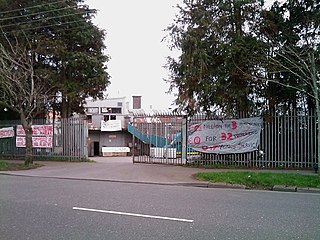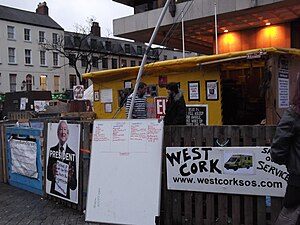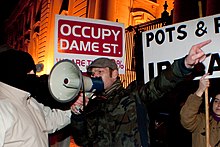
A series of riots in Dublin on 25 February 2006 was precipitated by a proposed march down O'Connell Street of a unionist demonstration. The disturbances began when members of the Garda Síochána attempted to disperse a group of counter-demonstrators blocking the route of the proposed march. The situation escalated as local youths joined forces with the counter-demonstrators.

Dame Street is a large thoroughfare in Dublin, Ireland.
Events from the year 2009 in Ireland.

The post-2008 Irish economic downturn in the Republic of Ireland, coincided with a series of banking scandals, followed the 1990s and 2000s Celtic Tiger period of rapid real economic growth fuelled by foreign direct investment, a subsequent property bubble which rendered the real economy uncompetitive, and an expansion in bank lending in the early 2000s. An initial slowdown in economic growth amid the international financial crisis of 2007–2008 greatly intensified in late 2008 and the country fell into recession for the first time since the 1980s. Emigration, as well as unemployment, escalated to levels not seen since that decade.
This is a summary of 2010 in Ireland.

Raidió Teilifís Éireann is an Irish public service broadcaster. It both produces and broadcasts programmes on television, radio and online. The radio service began on 1 January 1926, while regular television broadcasts began on 31 December 1961, making it one of the oldest continuously operating public service broadcasters in the world. It is headquartered in Donnybrook in Dublin, with offices across different parts of Ireland.
Gina Menzies is a frequent guest on Raidió Teilifís Éireann, the Irish national radio and television broadcaster and is described as a theologian.

Love/Hate is an Irish crime drama television series, commissioned by RTÉ Television and created by Stuart Carolan. Set in Dublin, the show depicts fictional characters in the city's criminal underworld. The show is mostly filmed in Dublin, with some scenes shot in bordering counties. Since its release, it continued to grow in popularity, with series 3 attracting close to one million viewers on several occasions.

The 2010 student protest in Dublin was a demonstration that took place in the centre of the city on 4th November 2010 in opposition to a proposed increase in university registration fees, further cuts to the student maintenance grant and increasing graduate unemployment and emigration levels caused by the 28th Government of Ireland.
Events during the year 2011 in Ireland.
Tubridy was a talk radio show, presented by Ryan Tubridy each weekday morning on RTÉ 2fm, from September 2010 until July 2015. Along with The Colm Hayes Show, which succeeded it on the schedules until 2013, Tubridy was intended as a long-term replacement for its long-running predecessor The Gerry Ryan Show.
This is a summary of the year 2012 in the Irish music industry.
Events during the year 2012 in Ireland.
Occupy Cork was a peaceful protest and demonstration against alleged economic inequality, social injustice and corporate greed taking place on the junction of the Grand Parade and South Mall and at the NAMA-listed Stapleton House on Oliver Plunkett Street in the Irish city of Cork. The group occupied Stapleton House after receiving the keys to the building on 25 December 2011. The camp was dismantled on 13 March 2012.

The Vita Cortex sit-in was a peaceful protest at the Vita Cortex plant on the Kinsale Road in Cork, Ireland, which began on 16 December 2011 after workers were made redundant without pay with immediate effect. The dispute led to nationwide protests, television appeals and debates in Dáil Éireann. According to the trade union UNITE, the dispute was part of a growing trend of workers being "left in the cold" after being made redundant.

The anti-austerity movement in Ireland saw major demonstrations from 2008 to 2015.

Roscommon University Hospital is a general hospital based in Roscommon, Ireland. It is situated on the N61 just outside Roscommon town. It is managed by Saolta University Health Care Group.
Events during the year 2013 in Ireland.

Raheny United Football Club is an Irish association football club based in Raheny, Dublin. Raheny United was founded in 1994 following the amalgamation of Raheny Boys and Dunseedy United. In 2017–18 their senior men's team compete in the Premier A division of the Athletic Union League. An over–35s team compete in the Amateur Football League. They also have 35 schoolboy teams competing in both the Dublin & District Schoolboy League and the North Dublin Schoolboys/Girls League.
On 1 May 2004 there was a physical confrontation in the Dublin suburb of Ashtown between riot police and alter-globalisation activists. On that day there was a summit of EU leaders taking place at Farmleigh House in the Phoenix Park. Protestors affiliated with the Dublin Grassroots Network and other left-wing groups attempted to march to Farmleigh but were blocked by Gardaí at the Ashtown roundabout. A small number of protestors broke off from the main group and clashed with Gardaí at the roundabout. The Gardaí used water cannons against the protestors, eventually dispersing them. This was the first time that police had used water cannons in the Republic of Ireland.












